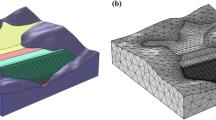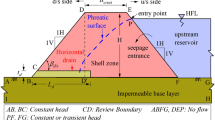Abstract
The stability of tailings dams is affected by seepage characteristics such as the location of the phreatic surface inside the dam, the effects of the capillary fringe, and the unsaturated zone above the zero pore pressure level. In this study, the performance of drainage systems in tailings dams was investigated by analyzing saturated and unsaturated seepage in the dam, considering the effects of the construction method, tailings properties, and the type of drainage systems. First, general seepage characteristics in tailings dams were studied and the effects of non-homogeneity were investigated. Our results show that in a silty tailings dam with a height of 15 m, unsaturated plus capillary seepage flux can reach 13% of the total seepage. The total head vs. discharge volume curves under various conditions were compared and their practical implications are presented. Then, stability analyses were carried out using the results of seepage analyses for different construction methods, material properties, and drainage systems. Finally, a number of practical conclusions are drawn regarding dam stability and the efficiency of toe, blanket, and chimney drains in different construction methods. Using a blanket and/or a chimney drain can increase the stability safety factor by up to two times, depending on the type of material.
Zusammenfassung
Die Stabilität von Absetzbecken ist beeinflusst durch die Eigenschaften des Sickerwassers wie die Lage der Sickerlinie im Damm, die Auswirkungen des Kapillarsaums und die ungesättigte Zone oberhalb des 0-Porendrucks. In dieser Studie wurde die Wirkung eines Entwässerungssystems in Dämmen untersucht durch Analyse der gesättigten und ungesättigten Sickerwasserzonen im Absetzbecken. Dabei wurden die Auswirkungen der Konstruktionsmethode, Schlammeigenschaften und die Art des Entwässerungssystems beachtet. Zuerst wurden die Sickereigenschaften im Absetzbecken und die Inhomogenitäten untersucht. Unser Ergebnis zeigt, dass bei einem schlammigen Absetzteich mit einer Höhe von 15 m, der Sickerwasserabfluß ca. 13% der ungesättigten Zone und des Kapillarsaum erreichen kann. Die Gesamthöhe der Entwässerungskurven wurden unter verschiedenen Bedingungen verglichen und ihre praktischen Auswirkungen dargestellt. Danach wurden Stabilitäts-Analysen durchgeführt, indem die Ergebnisse der Sickerwasser-Analysen für verschiedene Konstruktionsmethoden, Materialeigenschaften und Entwässerungssysteme berücksichtigt wurden. Letztendes konnten eine Anzahl praktischer Schlussfolgerungen gezogen werden, welche die Stabilität des Dammes und die Effizienz von Abdichtung, der Überdeckung sowie der Entwässerungskanäle in unterschiedlichen Konstruktionsmethoden betreffen. Durch die Art der Überdeckung und Entwässerungskanäle kann der Stabilitätsfaktor, abhängig vom verwendeten Material, verdoppelt werden.
Resumen
La estabilidad de los diques de cola es afectada por las características de las infiltraciones como la localización de la superficie freática dentro del dique, los efectos de la franja capilar, y la zona insaturada debajo del nivel de presión de poro cero. En este estudio, se investigó el comportamiento de los sistemas de drenaje en diques de cola por análisis de las infiltraciones saturadas e insaturadas en el dique considerando los efectos del método de construcción, las propiedades de las colas y el tipo de sistema de drenaje. Primero, se estudiaron las características de las infiltraciones generales en el dique y los efectos de la no homegeneidad. Los resultados muestran que en un dique de colas con una altura de 15 m, la infiltración insaturada y la capilar pueden alcanzar un 13% del total. Se compararon las curvas de cabeza versus volumen de descarga bajo varias condiciones y sus implicancias prácticas se presentan en este trabajo. Luego, se realizaron análisis de estabilidad usando los análisis de iinfiltraciones para diferentes métodos de construcción, propiedades de materiales y sistemas de drenaje. Finalmente, se elaboraron conclusiones prácticas respecto de la estabilidad del dique y la eficiencia de los drenajes tipo chimenea, base o manta en diferentes métodos de construcción. Usando un drenaje tipo manta o tipo chimenea puede incrementarse la estabilidad hasta el doble dependiendo del tipo de material.
抽象
尾矿坝体稳定性受坝体内潜水面位置、毛润前锋、零孔隙压力以上非饱和带等渗流特征影响。考虑坝体堆积方法、尾矿特性和排水系统类型,分析了尾矿坝内饱和与非饱和渗流特征,研究了尾矿坝排水系统的功能状况。首先,研究了尾矿坝内渗流总体特征及非均质特性。15m高粉质粘土尾矿坝非饱和正毛细渗流通量可达总渗流通量的13%,同时对比了多种条件下总水头~总排水量关系曲线及含义。然后,依据不同堆积方法、材料性能和排水系统的渗流特征分析坝体稳定性。最后,得到不同堆积方式下墙趾、垫层、土坝垂直排水系统的排水效率和坝体稳定性。依据坝体材料不同,采用垫层和/或垂直排水系统能将坝体稳定性安全因子提高近2倍。











Similar content being viewed by others
References
Abadjiev CB (1976) Seepage through mill tailings dams. Trans, 12th ICOLD, Mexico City, vol 1, pp 381–393
Boufadel MC, Suidan MT, Venosa AD, Bowers MT (1999) Steady seepage in trenches and dams: effect of capillary flow. J Hydraul Eng ASCE 125(3):286–294
Brooks RH, Corey AT (1966) Properties of porous media affecting fluid flow. J Irrig Drain E-ASCE 92(2):61–88
Bruch PG (1993) A laboratory study of evaporative fluxes in homogeneous and layered soils. MSc Thesis, Dept of Civil Eng, University of Saskatchewan, Saskatoon, Canada
Bussière B, Chapuis RP, Aubertin M (2003) Unsaturated flow modeling for exposed and covered tailings dams. In: Proceedings of international symposium on major challenges in tailings dams, pp 57–70
Chapuis RP, Aubertin M (2001) A simplified method to estimate saturated and unsaturated seepage through dikes under steady state conditions. Can Geotech J 38(6):1321–1328
Corey AT (1957) Measurement of water and air permeability in unsaturated soil. Soil Sci Soc Am J 21(1):7–10
Davies MP (2002) Tailings impoundment failures: are geotechnical engineers listening. Geotech News, pp 31–36
Delleur JW (2006) The handbook of groundwater engineering, 2nd edn. CRC Press, New York
Dogan A, Motz LH (2005) Saturated-unsaturated 3D groundwater model, І: development. J Hydraul Eng ASCE 10(6):492–504
Elzeftawy A, Cartwright K (1981) Evaluating the saturated and unsaturated hydraulic conductivity of soils. Permeability and groundwater contaminant transport, ASTM STP, pp 168–181
Fredlund DG, Rahardjo H (1993) Soil mechanics for unsaturated soils. Wiley, New York
Fredlund DG, Xing A, Huang S (1994) Predicting the permeability function for unsaturated soils using the soil-water characteristic curve. Can Geotech J 31(4):533–546
Freeze RA (1971) Influence of the unsaturated flow domain on seepage through earth dams. Water Resour Res 7(4):929–941
Fu JF, Sheng JI (2009) A study on unsteady seepage flow through dam. J Hydrodyn 21(4):499–504
Geo-Slope International Ltd. (2002) SeepW User’s Guide. Geo-Slope International Ltd, Calgary
Gonzalez PA, Adams BJ (1980) Mine tailings disposal (No. UTCE-80-06). University of Toronto, Canada
Green RE, Corey JC (1971) Calculation of hydraulic conductivity: a further evaluation of some predictive methods. Soil Sci Soc Am J 35(1):3–8
Houston WN, Houston SL, Al-Samahiji D (2000) Water content and soil suction in the capillary zone. In: Proceedings of Asian conference on unsaturated soils, Singapore, pp 387–391
Ito M, Azam S (2013) Large-strain consolidation modeling of mine waste tailings. Environ Syst Res 2(1):7
Kovács G (2011) Seepage hydraulics, vol 10. Elsevier, New York
Lee LM, Gofar N, Rahardjo H (2009) A simple model for preliminary evaluation of rainfall-induced slope instability. Eng Geol 108(3):272–285
Leoni GL, Almeida MD, Fernandes HM (2004) Computational modeling of final covers for uranium mill tailings impoundments. J Hazard Mater 110(1):139–149
Lottermoser BG, Ashley PM (2005) Tailings dam seepage at the rehabilitated Mary Kathleen uranium mine, Australia. J Geochem Explor 85(3):119–137
Lu N, Likos WJ (2004) Rate of capillary rise in soil. J Geotech Geoenviron 130(6):646–650
McWhorter DB, Nelson JD (1980) Seepage in the partially saturated zone beneath tailing impoundments. Min Eng 32(4):432–439
Mishra GC, Singh AK (2005) Seepage through a levee. Int J Geomech 5(1):74–79
Mittal HK, Morgenstern NR (1977) Design and performance of tailings dams. In: Proceedings of ASCE geotechnical specialty conference, pp 475–492
Nabipour M (2006) Investigation and analysis of seepage through body of tailings dams using numerical modeling. MSc Thesis, Sharif Univ of Technology, Tehran, Iran (in Persian)
Rico M, Benito G, Salgueiro AR, Diez-Herrero A, Pereira HG (2008) Reported tailings dam failures: a review of the European incidents in the worldwide context. J Hazard Mater 152(2):846–852
Rykaart M, Fredlund M, Stianson J (2002) Modelling tailings dam flux boundary condition with 3D seepage software. Ground Eng 35(7):28–30
Saad B, Mitri H (2011) Hydromechanical analysis of upstream tailings disposal facilities. J Geotech Geoenviron 137(1):27–42
Sharma RS, Al-Busaidi TS (2001) Groundwater pollution due to a tailings dam. Eng Geol 60(1):235–244
Shen L, Luo S, Zeng X, Wang H (2011) Review on anti-seepage technology development of tailings pond in China. Proced Eng 26:1803–1809
Stauffer PA, Obermeyer JR (1988) Pore water pressure condition in tailings dams. Hydraulic fill structures, Proceedings of ASCE special conference, pp 924–939.
Swanson DA, Savci G, Danziger G, Mohr RN, Weiskopf T (1999) Predicting the soil-water characteristics of mine soils. In: Proceedings of 6th international conference on tailings and mine waste conference, pp 345–349
Thieu NT, Fredlund DG, Hung VQ (2000) General partial differential equation solvers for saturated-unsaturated seepage. In: Proceedings of Asian conference on unsaturated soils, Singapore, pp 201–206
UNEP (1994) Tailings dams-design of drainage. Bull 97, International Commission on Large Dams, Paris
UNEP (1996) A guide to tailings dams and impoundments, design, construction, use and rehabilitation. Bull 106, International Commission on Large Dams, Paris
UNEP (2001) Tailings dams risk of dangerous occurrences. Bull 121, International Commission on Large Dams, Paris
US EPA (1994) Technical report: design and evaluation of tailing dams. Office of Solid Waste, US Environmental Protection Agency, Washington DC
Valipour M (2012) A comparison between horizontal and vertical drainage systems (include pipe drainage, open ditch drainage, and pumped wells) in anisotropic soils. IOSR J Mech Civil Eng 4(1):7–12
Van Genuchten MT (1980) A closed-form equation for predicting the hydraulic conductivity of unsaturated soils. Soil Sci Soc Am J 44(5):892–898
Van Zyl D, Robertson AM, Mac G (1980) Subsurface drainage of tailing impoundments some design, construction and management considerations. In: Proceedings of symposium on uranium mill tailings management, Colorado State University, pp 153–177
Vick SV (1983) Planning, design and analysis of tailings dams. BiTech Publ, Vancouver
Yi Y, Wei S, Shufen L (2011) Tailings dam stability analysis of the process of recovery. Proced Eng 26:1782–1787
Yin G, Li G, Wei Z, Wan L, Shui G, Jing X (2011) Stability analysis of a copper tailings dam via laboratory model tests: a Chinese case study. Miner Eng 24(2):122–130
Zandarin MT, Oldecop LA, Rodriguez R, Zabala F (2009) The role of capillary water in the stability of tailing dams. Eng Geol 105(1):108–118
Zhang LT, Qi QL, Xiong BL, Zhang J (2011) Numerical simulation of 3-D seepage field in tailing pond and its practical application. Proced Eng 12:170–176
Author information
Authors and Affiliations
Corresponding author
Electronic supplementary material
Below is the link to the electronic supplementary material.
Rights and permissions
About this article
Cite this article
Pak, A., Nabipour, M. Numerical Study of the Effects of Drainage Systems on Saturated/Unsaturated Seepage and Stability of Tailings Dams. Mine Water Environ 36, 341–355 (2017). https://doi.org/10.1007/s10230-017-0468-y
Received:
Accepted:
Published:
Issue Date:
DOI: https://doi.org/10.1007/s10230-017-0468-y




